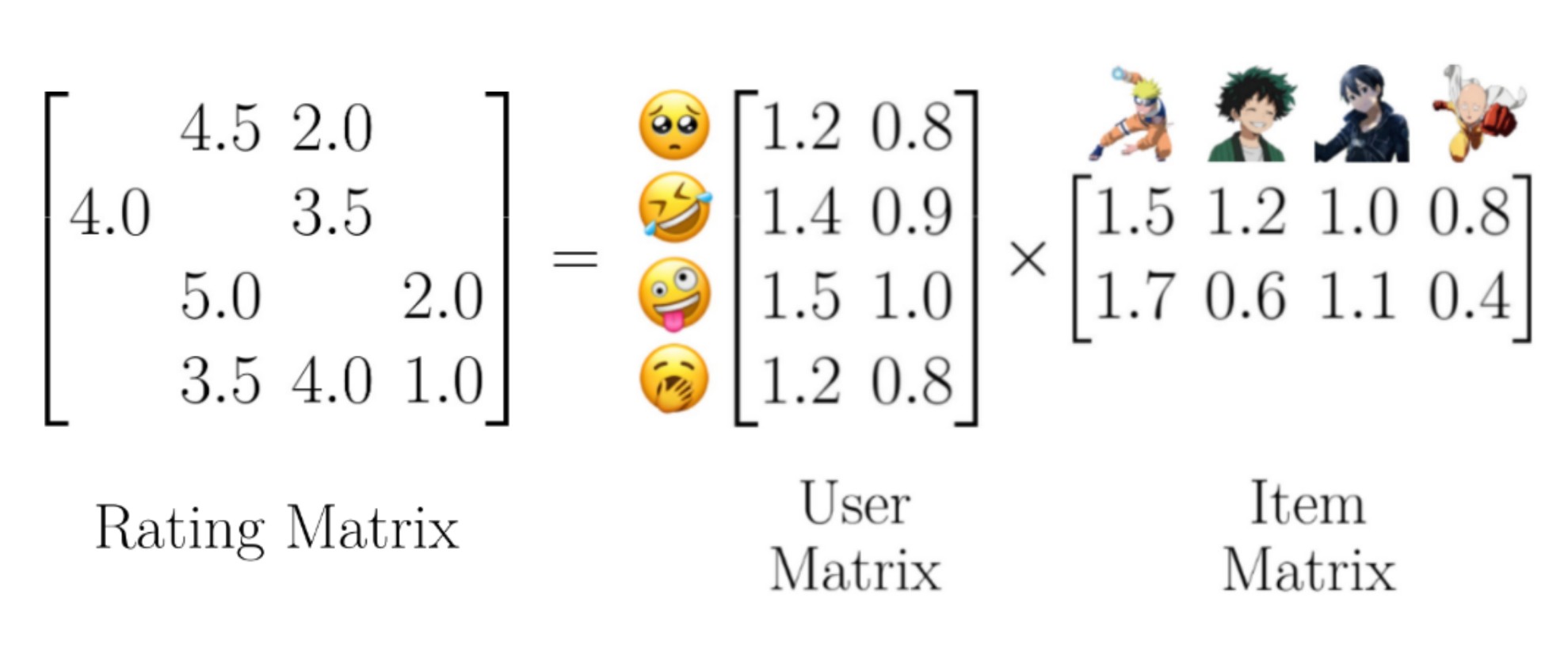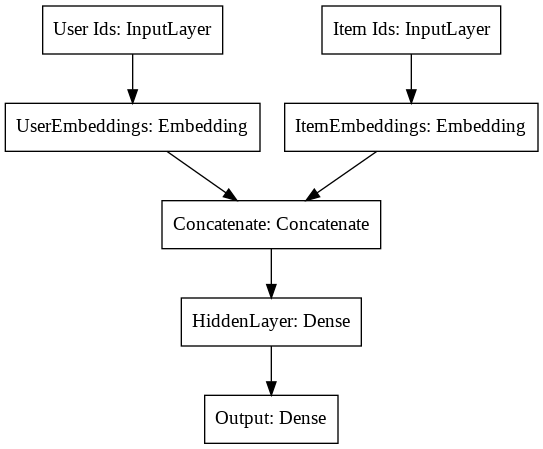Goal of this repo is to document the development of user-item recommendation systems, and compare different methods. Dataset used is Anime Recommendation Database 2020 from Kaggle. All the models can be downloaded from the Drive.
There are two most common ways of making recommending:
- Colaborative filtering – methods of making predictions about the interests of a user by collecting preferences or taste information from many users.
- Content-based filtering – making predictions based on a description of the item and a profile of the user's preferences.
Right now we will focus only on colaborative filtering.
One of the ways to recommend items is by predicting what rating will a user put on an item, and showing the ones that user hasn't seen and have the highest rating.
Matrix factorization algorithms work by decomposing the user-item interaction matrix into the product of two lower dimensionality rectangular matrices. For example, using the anime rating matrix we can try to learn the user and anime matrices, such that each row and column represent a user and an anime respectively.
We are never actually going to create this rating matrix, however it is better to imagine it like that.
Making the tf.keras.Model
Instead of user and item matrices, we will use embeddings, which will map each user and anime to a vector. In addition, we'll add a bias to each user and anime.
class MatrixFactorizationModel(tf.keras.Model):
def __init__(self, num_users, num_items, embedding_dim):
super(MatrixFactorizationModel, self).__init__()
self.embedding_dim = embedding_dim
self.user_embeddings = tf.keras.layers.Embedding(num_users, embedding_dim)
self.item_embeddings = tf.keras.layers.Embedding(num_items, embedding_dim)
self.user_biases = tf.keras.layers.Embedding(num_users, 1)
self.item_biases = tf.keras.layers.Embedding(num_items, 1)
self.bias = tf.Variable(tf.zeros([1]))
self.dropout = tf.keras.layers.Dropout(.5)
def call(self, inputs, training = False):
...It is a good practice to place a dropout layer over embedding layers to prevent overfitting and in turn, making features more robust. To compute the predicted rating I use the formula prediction = (user_embedding + user_bias) * (item_embedding + item_bias) + bias.
class MatrixFactorizationModel(tf.keras.Model):
def __init__(self, num_users, num_items, embedding_dim):
...
def call(self, inputs, training = False):
user_ids = inputs[:, 0]
item_ids = inputs[:, 1]
user_embedding = self.user_embeddings(user_ids) + self.user_biases(user_ids)
item_embedding = self.item_embeddings(item_ids) + self.item_biases(item_ids)
if training:
user_embedding = self.dropout(user_embedding, training = training)
item_embedding = self.dropout(item_embedding, training = training)
user_embedding = tf.reshape(user_embedding, [-1, self.embedding_dim])
item_embedding = tf.reshape(item_embedding, [-1, self.embedding_dim])
dot = tf.keras.layers.Dot(axes=1)([user_embedding, item_embedding]) + self.bias
return dotTo compile the model I used Adam optimizer, MSE as the loss and RMSE as a metric to keep track of. The model is ran eagerly, to allow such model definition.
mf_model = MatrixFactorizationModel(num_users = num_users,
num_items = num_anime,
embedding_dim = 64)
mf_model.compile(
optimizer = tf.keras.optimizers.Adam(),
loss = tf.keras.losses.MeanSquaredError(),
metrics = [
tf.keras.metrics.RootMeanSquaredError("RMSE")
],
run_eagerly = True
)The neural network will try to learn user and item embeddings that model user-item interactions.
Model sctructure is quite similar to that of MatrixFactorization, however now we will concatenate user and anime embeddings and pass them through two dense layers. Last layer has only one node and its output will represent the predicted rating.
Making the tf.keras.Model
Let's define the user and item embeddings and the two dense layers. I used relu activation on the output layer because predictions non-negative numbers.
class NeuralNetworkModel(tf.keras.Model):
def __init__(self, num_users, num_items, embedding_dim):
super(NeuralNetworkModel, self).__init__()
self.embedding_dim = embedding_dim
self.user_embeddings = tf.keras.layers.Embedding(num_users, embedding_dim)
self.item_embeddings = tf.keras.layers.Embedding(num_items, embedding_dim)
self.dense1 = tf.keras.layers.Dense(64, activation='relu')
self.dense2 = tf.keras.layers.Dense(1, activation='relu')
self.concat = tf.keras.layers.Concatenate()
self.dropout = tf.keras.layers.Dropout(.5)
def call(self, inputs, training = False):
...We'll take user and item embeddings, apply dropout after each, and concatenate them. Then we'll pass them through two dense layers.
class NeuralNetworkModel(tf.keras.Model):
def __init__(self, num_users, num_items, embedding_dim):
...
def call(self, inputs, training = False):
user_ids = inputs[:, 0]
item_ids = inputs[:, 1]
user_embedding = self.user_embeddings(user_ids)
item_embedding = self.item_embeddings(item_ids)
if training:
user_embedding = self.dropout(user_embedding, training = training)
item_embedding = self.dropout(item_embedding, training = training)
user_embedding = tf.reshape(user_embedding, [-1, self.embedding_dim])
item_embedding = tf.reshape(item_embedding, [-1, self.embedding_dim])
x = self.concat([user_embedding, item_embedding])
x = self.dense1(x)
x = self.dense2(x)
return xSimilarly to MatrixFactorization, to compile the model I used Adam optimizer, MSE as the loss and RMSE as a metric to keep track of. The model is ran eagerly, to allow such model definition.
nn_model = NeuralNetworkModel(num_users = num_users,
num_items = num_anime,
embedding_dim = 64)
nn_model.compile(
optimizer = tf.keras.optimizers.Adam(),
loss = tf.keras.losses.MeanSquaredError(),
metrics = [
tf.keras.metrics.RootMeanSquaredError("RMSE")
],
run_eagerly = True
)Being able to predict what rating will a user place on an anime is nice. However, our goal is to recommend anime. So, basically, we can rephrase our question to will a user have a positive interaction with an anime?
Let's define positive and negative interactions as
1: user liked the anime, watched it all, and placed a good rating;0: user dropped the anime, placed a low rating.
Now, we can use exactly the same model structures, except with a sigmoid function applied to the output.
In our anime dataset we don't have a positive-negative interaction column, so we will make it ourselves.
We'll leave only Completed and Dropped columns. All the anime rated less than or equal 5 or that were dropped, will be considered negative interactions. Rest are positive.
watching_status values:
1: Currently Watching
2: Completed
3: On Hold
4: Dropped
6: Plan to Watch
interactions = interactions[interactions["watching_status"] <= 4] # leave only
interactions = interactions[interactions["watching_status"] >= 2] # watching_status that
interactions = interactions[interactions["watching_status"] != 3] # are 2 or 4
def transform(df):
df.loc[df["rating"] <= 5, ["watching_status"]] = 0.0
df.loc[df["watching_status"] == 2, ["watching_status"]] = 1.0
df.loc[df["watching_status"] == 4, ["watching_status"]] = 0.0
df.rename(columns = {'watching_status': 'interaction'}, inplace = True)
transform(interactions)
good = interactions['user_id'].value_counts().loc[lambda x : x > 4].unique() # we will consider a user if they
interactions = interactions[interactions["user_id"].isin(good)] # have more than 4 occurances(IMHO) A model that has multiple tasks can perform better because of more diverse data. We can make a predictor that will achive both tasks, predict user-item ratings and interactions.
As it has two tasks, model loss function will be the sum of two loss functions for each task multiplied by importance weights.
Making the tf.keras.Model
Model structure is similar to Neural Networs used for rating and interaction predictions, however now it has both outputs (dense2 and dense3 layers).
class HybridNeuralNetworkModel(tf.keras.Model):
def __init__(self, num_users, num_items, embedding_dim):
super(HybridNeuralNetworkModel, self).__init__()
self.embedding_dim = embedding_dim
self.user_embeddings = tf.keras.layers.Embedding(num_users, embedding_dim)
self.item_embeddings = tf.keras.layers.Embedding(num_items, embedding_dim)
self.dense1 = tf.keras.layers.Dense(64, activation='relu')
self.dense2 = tf.keras.layers.Dense(1, activation='relu')
self.dense3 = tf.keras.layers.Dense(1, activation='sigmoid')
self.concat = tf.keras.layers.Concatenate()
self.dropout = tf.keras.layers.Dropout(.5)
def call(self, inputs, training = False):
...In output scence it is also similar, except now it returns two outputs.
class HybridNeuralNetworkModel(tf.keras.Model):
def __init__(self, num_users, num_items, embedding_dim):
...
def call(self, inputs, training = False):
user_ids = inputs[:, 0]
item_ids = inputs[:, 1]
user_embedding = self.user_embeddings(user_ids)
item_embedding = self.item_embeddings(item_ids)
if training:
user_embedding = self.dropout(user_embedding, training = training)
item_embedding = self.dropout(item_embedding, training = training)
user_embedding = tf.reshape(user_embedding, [-1, self.embedding_dim])
item_embedding = tf.reshape(item_embedding, [-1, self.embedding_dim])
conc = self.concat([user_embedding, item_embedding])
x = self.dense1(conc)
x1 = self.dense2(x)
x2 = self.dense3(x)
return x1, x2Each output will have its own loss function defined, as well as evaluation metrics. Lambda values in the formula above are configured in the loss_weights.
hnn_model = HybridNeuralNetworkModel(num_users = num_users,
num_items = num_anime,
embedding_dim = 64)
hnn_model.compile(
optimizer = tf.keras.optimizers.Adam(),
loss = {
"output_1": tf.keras.losses.MeanSquaredError(),
"output_2": tf.keras.losses.BinaryCrossentropy()
},
loss_weights = {
"output_1": 1.0,
"output_2": 5.0
},
metrics = {
"output_1": [
tf.keras.metrics.RootMeanSquaredError("RMSE")
],
"output_2": [
tf.keras.metrics.BinaryAccuracy("Acc"),
tf.keras.metrics.Precision(name = "P"),
tf.keras.metrics.Recall(name = "R")
]
},
run_eagerly = True
)| Model | val_loss | RMSE |
|---|---|---|
| Hybrid NN | 1.9694 | 1.4034 |
| Neural Network | 1.9897 | 1.4105 |
| Matrix Factorization | 2.8429 | 1.6861 |
| Model | val_loss | Acc | Precision | Recall |
|---|---|---|---|---|
| Hybrid NN | 0.3079 | 0.8790 | 0.8931 | 0.9759 |
| Neural Network | 0.2502 | 0.8050 | 0.8907 | 0.8282 |
| Matrix Factorization | 0.4691 | 0.7678 | 0.8969 | 0.7621 |






